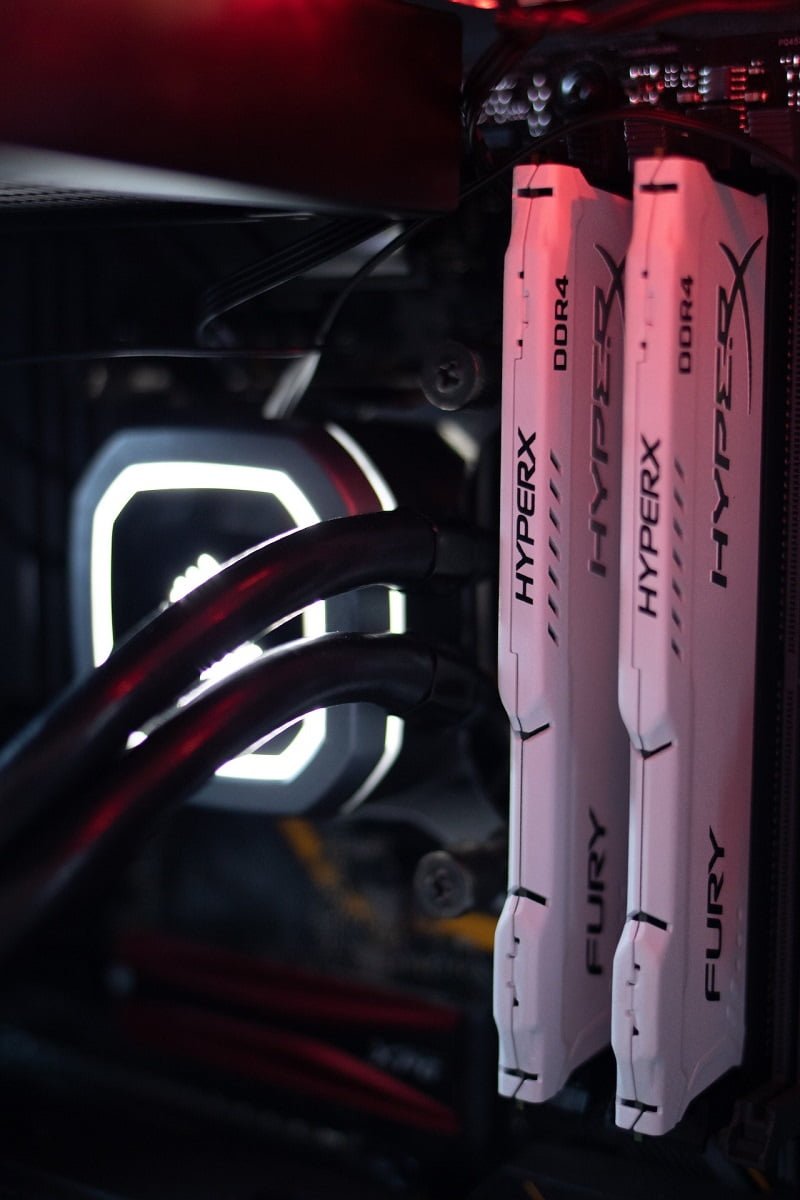There is a lot of debate over what hardware affects gaming performance the most: graphics cards, processors, or RAM. This post will look at RAM capacity and FPS in gaming computers. We’ll also discuss the advantages of having higher RAM in gaming and dispel myths about how much RAM you need to achieve optimal gaming performance.
Table of Contents
What is RAM?
RAM, short for Random Access Memory, is a type of computer memory that can be accessed randomly, meaning any piece of data can be returned in a constant amount of time regardless of its physical location. RAM is used to store data that needs to be readily available for the CPU to access. FPS, or frames per second, measures how many images your computer can generate per second. The higher the FPS, the smoother and more realistic the game graphics will be. You generally want your FPS to be as high as possible for the best gaming experience. However, other factors affect FPS besides RAM capacity. These factors include:
- Graphics card
- Processor
- Game settings
- In-game activity
That being said, RAM capacity impacts FPS and, as a result, your gaming experience. Here’s a more detailed explanation of how RAM affects FPS.
How Does RAM Affect FPS?
RAM speed and size can directly affect FPS. RAM speed or RAM frequency is essential to ensure the tasks run smoothly, especially games. This is because higher RAM speed leads to larger memory bandwidth, making data transactions between the memory and CPU more effective.
On the other hand, RAM size is important because it stores data on the tasks. Size is arguably even more significant to FPS since you won’t benefit from RAM speed if you don’t have the space to store the data. Both these aspects ensure that the computer’s components run at a high level to give you a seamless user experience.
However, the notion of RAM affecting FPS doesn’t always work. For instance, adding other RAM sticks won’t change performance if your gaming PC has 8GB RAM and a game uses only 4GB RAM. The technique only works when the game requires a RAM size higher than your capacity. For example, if your gaming PC has 8GB and the game needs 16GB, adding an 8GB RAM stick will provide better performance.
How Does RAM Affect Gaming?
We’ve already established that RAM affects FPS and, as a result, your gaming experience. But how does it affect gaming specifically? Let’s take a look.
As we mentioned before, RAM stores data that the CPU needs to access. This data includes in-game assets, textures, shaders, and game maps. When you’re gaming, your computer is constantly loading data into RAM so that the CPU can access it quickly.
If your RAM is full, the CPU must wait for the data to be unloaded before it can access new data, leading to FPS lag. Conversely, if you have more RAM than the game requires, the CPU can access the data much quicker, leading to smoother gameplay and a better gaming experience.
So, if you’re looking to improve your gaming experience, one of the best things you can do is upgrade your RAM. More RAM means that your games will run more smoothly and quickly, giving you a competitive edge and a more enjoyable experience overall. Using a higher-frequency RAM stick can also solve your performance issues. For example, 8 GB RAM between 2133 MHz and 2666MHz will provide better gaming performance since it can offer faster data transfer to the CPU.
The gaming world is ever-changing, and RAM needs are continuously rising. As games become more demanding, the need for higher RAM capacities will only grow. So, if you’re looking to stay ahead of the curve and ensure a top-notch gaming experience, make sure your gaming PC has plenty of RAM. For instance, 16GB RAM is a good starting point for most gamers, especially since using a 32 GB RAM stick might not provide that much difference in performance.
Despite this argument, buying 32 GB RAM to future-proof yourself doesn’t hurt.
How Much RAM is Needed for Gaming?
The amount of RAM you need for gaming depends on the games you want to play and at what resolution. For example, if you play demanding games like Battlefield V or Metro Exodus at 1080p resolution, you will need at least 16GB RAM for a seamless gaming experience.
However, if you’re looking to game at a 1440p or even a 3440 x 1440p resolution, you’re going to need more RAM. For instance, games like Assassin’s Creed Odyssey or The Witcher III require at least 32GB of RAM when played at those resolutions.
It’s important to note that these requirements are for ideal gaming experiences. You will need even more RAM if you want to play the latest games at the highest resolutions with all the settings maxed out.
For example, if you want to play Cyberpunk 2077 at a resolution of 3840 x 1600 with all the settings maxed out, you’ll need at least 64GB RAM.
Of course, not everyone is looking to game at such high resolutions. If you’re content with playing at 1080p or even 1440p, you can get away with using less RAM. For instance, if you want to play games like Fortnite or Apex Legends at those resolutions, you only need 16GB RAM.
So, how much RAM do you need for gaming? It depends on the games you want to play and the resolution. If you’re looking to game at high resolutions with all the settings maxed out, you’ll need a lot of RAM. However, if you’re content with playing at lower resolutions, you can get away with using less RAM.
Frequently Asked Questions
What is the relationship between FPS and RAM?
The relationship between FPS and RAM is a complicated one. More RAM can mean better FPS, but it’s not always that simple. If your RAM is full, the CPU will have to wait for the data to be unloaded before it can access new data, which can lead to FPS lag. Conversely, if you have more RAM than the game requires, the CPU can access the data much quicker, leading to smoother gameplay and a better gaming experience.
What is the difference between DDR RAM and regular RAM?
DDR RAM is a type of RAM that is designed to work with CPUs that have a dual-data rate. This means that it can send data twice as fast as regular RAM. DDR RAM is also available in different frequencies so that it can transmit data at different speeds. The faster the frequency, the quicker the data can be sent, and the better the performance.
How do I calculate memory bandwidth?
Memory bandwidth is the amount of data that can be transferred between the RAM and the CPU in a given period. It is calculated by multiplying the size of the data bus by the frequency of the RAM. For example, if you have a 64-bit DDR RAM with a frequency of 1600 MHz, your memory bandwidth would be 64 bits x 1600 MHz, or 102.400 GB/s.
What is the difference between single-channel and dual-channel memory?
Single-channel memory is a type of RAM that uses one data channel to communicate with the CPU. Dual-channel memory is a type of RAM that uses two data channels to communicate with the CPU. Dual-channel memory is typically faster than single-channel memory because it can send twice as much data in the same amount of time.
Can Dual-Channeling your RAM Affect FPS?
The short answer is yes, dual channeling your RAM can affect FPS. The long answer is a bit more complicated. Dual channeling your RAM can improve FPS by up to 30%, but it can also lead to higher CPU usage, which can offset the gains in FPS. Ultimately, whether or not you should use dual channels, your RAM depends on the games you’re playing and your desired gaming experience.
What Does DDR4 Mean?
DDR4 stands for double data rate fourth generation. DDR4 RAM is the latest gen of RAM that is designed to work more efficiently. The DDR section of the name means double rate, meaning it can send data twice as fast as regular RAM. DDR RAM is also available in different frequencies, sending data at different speeds.
How does low RAM affect gaming?
Low RAM can affect gaming in a number of ways:
- If your RAM is full, the CPU must wait before accessing more data. This, in turn, leads to FPS lag. If you have more RAM than the game requires, the CPU can access the data much quicker, leading to smoother gameplay.
- If you have low RAM, your computer may start swapping data from the RAM to the hard drive, leading to even more FPS lag.
Conclusion
In conclusion, the amount of RAM you need for gaming depends on the games you want to play and at what resolution. If you’re looking to game at high resolutions with all the settings maxed out, you’re going to need a lot of RAM. However, if you’re content with playing at lower resolutions, you can get away with using less RAM. DDR RAM is the latest generation of RAM and is designed to work more efficiently. Ultimately, the decision of how much RAM to use in gaming comes down to the individual’s desired gaming experience.










